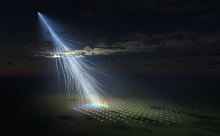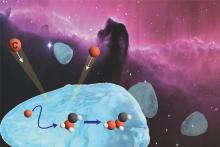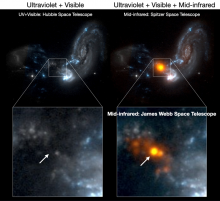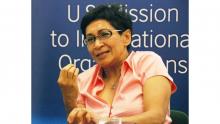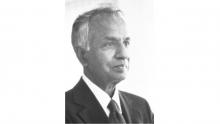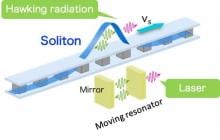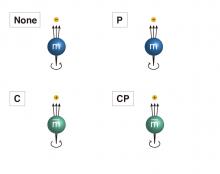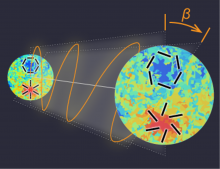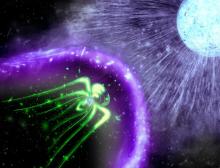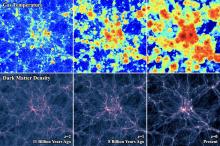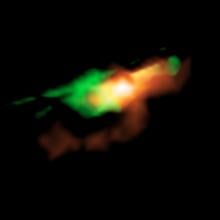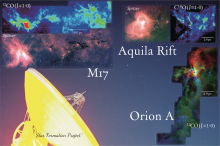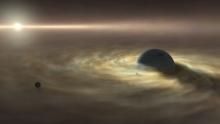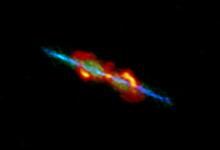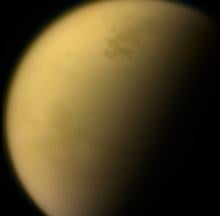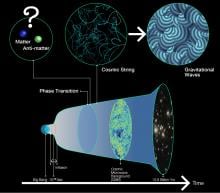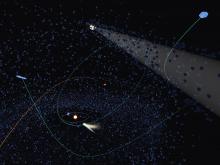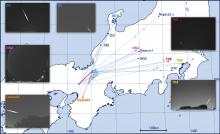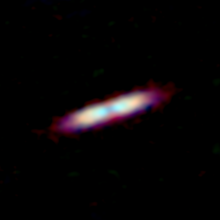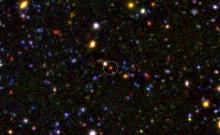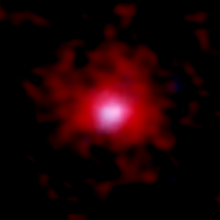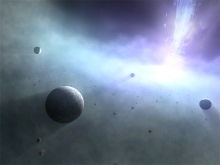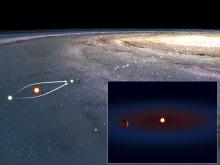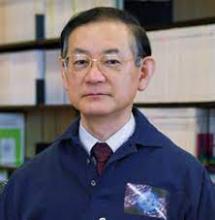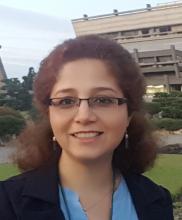Physics Astrophysics
News
22 Nov 2023
Osaka Metropolitan University researchers and their colleagues have successfully detected an ultra-high-energy cosmic ray with an energy level comparable to the most energetic cosmic ray ever observed. The cosmic ray is set to be named after the Japanese sun goddess, Amaterasu. No promising astronomical object has been identified in the direction from which this cosmic ray originated, implying the potential existence of unknown astronomical phenomena and novel physical origins beyond the Standard Model.
16 Nov 2023
… all while discovering how the Universe evolved, how galaxies form and where the elements come from.
12 Oct 2023
Osaka Metropolitan University scientists, in cooperation with researchers from the National Astronomical Observatory of Japan, have captured cosmic-ray extensive air showers with unprecedented precision using the prime-focus wide field camera mounted on the Subaru Telescope, situated atop Mauna Kea in Hawaii. Analyzing approximately 17,000 images captured between 2014 and 2020, they pinpointed 13 images containing extensive air showers, with a number of particle tracks far exceeding the usual count.
14 Sep 2023
Lab-based studies reveal how carbon atoms diffuse on the surface of interstellar ice grains to form complex organic compounds, crucial to reveal the chemical complexity in the universe.
01 Mar 2023
An international research team has discovered the first example of a supernova, known as SN 2018ivc, showing an unprecedented rebrightening at millimeter wavelengths about one year after the explosion.
With the help of the Atacama Large Millimeter/submillimeter Array -- or ALMA -- the analysis revealed that the dying massive star ejected a large amount of its envelope due to a strong binary interaction with a companion star that took place about 1500 years before the explosion.
In a paper published in The Astrophysical Journal Letters, the team posits that this rebrightening event in SN 2018ivc provides a missing link between supernovae -- or SN -- that occur in binary star systems and those that involve solitary massive stars.
03 Feb 2023
Researchers used the James Webb Space Telescope to identify the precise location of a powerful energy source hidden by cosmic dust in the luminous merging galaxy IIZw096.
20 Jan 2023
Overeating mechanism: why "eating just one chip"🍟 is impossible, Measuring hidden energy of gamma-ray bursts, Marine species that can adapt to ocean acidification & A rough start can lead to a strong bond, Read all in our first Editor's Choice of 2023. Plus our interview on what dengue vaccine approval in EU💉means for global dengue protection.
18 Nov 2022
Exploring virtual human-agent relationships, A fly protein gives clue for human cancers, Rare earth elements formed in neutron star mergers 💥, One-stop process for hydrogen production. Read all in the November's Editor's Choice plus Upcoming event K4DM KNOWLEDGE MARKETPLACE – Bangkok 2022: Exchanging Ideas for a Democratic Myanmar.
03 Oct 2022
Supermassive black holes can launch fast-moving plasma, which emit strong radio signals known as radio jets. Despite being discovered over 40 years ago, much remains unknown about how radio jets are produced. Now, a research team, led by Tohoku University astrophysicists, has attempted to clarify how plasma gets loaded into radio jets.
21 Sep 2022
Giants in History: Malaysia’s first astrophysicist, Mazlan binti Othman (born 11 December 1951) was instrumental in launching the country’s first microsatellite, and in sending Malaysia’s first astronaut, Sheikh Muszaphar Shukor, into space.
30 Mar 2022
Giants in History: Subrahmanyan Chandrasekhar (19 October 1910 – 21 August 1995) was an Indian astrophysicist who studied the structure and evolution of stars.
08 Oct 2021
Researchers propose quantum circuit black hole lasers to explore Hawking radiation
21 Dec 2020
In the 1970s, physicists uncovered a problem with the Standard Model of particle physics—the theory that describes three of the four fundamental forces of nature (electromagnetic, weak, and strong interactions; the fourth is gravity). They found that, while the theory predicts that a symmetry between particles and forces in our Universe and a mirror version should be broken, the experiments say otherwise. This mismatch between theory and observations is dubbed “the Strong CP problem”—CP stands for Charge+Parity. What is the CP problem, and why has it puzzled scientists for almost half a century?
02 Dec 2020
Yuto Minami at KEK and Eiichiro Komatsu at Kavli IPMU developed a new method to calibrate detectors to the light from dust in our Galaxy, thereby describing a new physics, with 99.2 percent accuracy, that may show parity symmetry breaking.
02 Dec 2020
A research team led by Kavli IPMU graduate student Hiroki Yoneda has shed new night on the massive star and its neutron star companion, which are thought to be at the core of the gamma-ray binary system LS 5039.
13 Nov 2020
How hot is the Universe today? How hot was it before? A new study by an international team of researchers, including members of the Kavli Institute for the Physics and Mathematics of the Universe (Kavli IPMU), suggests that the mean temperature of gas in large structures of the Universe has increased about 3 times in the last 8 billion years, to reach about two million Kelvin today.
27 Mar 2020
Astronomers obtained the first resolved image of disturbed gaseous clouds in a galaxy 11 billion light-years away by using ALMA.
24 Mar 2020
Astronomers have captured new, detailed maps of three nearby interstellar gas clouds containing regions of ongoing high-mass star formation.
09 Mar 2020
Researchers found that dust encircling a young gas giant can create a “safety zone,” which keeps a large moon from falling into the planet as the system evolves.
05 Mar 2020
An international team of astronomers using ALMA has captured the very moment when an old star first starts to alter its environment.
14 Feb 2020
Planetary scientists using ALMA revealed the secrets of the atmosphere of Titan, the largest moon of Saturn.
03 Feb 2020
Gravitational waves could contain evidence to prove that neutrino particles reshuffled matter and anti-matter, explains a new study.
17 Jan 2020
Astronomers at the National Astronomical Observatory of Japan have analyzed the paths of two objects heading out of the Solar System and determined that they likely originated from outside of the Solar System.
15 Jan 2020
Astronomers uncovered the true identity of the fireball spotted on April 29, 2017.
23 Dec 2019
Astronomers using the Atacama Large Millimeter/submillimeter Array (ALMA) found a young star surrounded by an astonishing mass of gas.
19 Dec 2019
A distant galaxy more massive than our Milky Way has revealed that the 'cores' of massive galaxies in the Universe had formed already 1.5 billion years after the Big Bang.
16 Dec 2019
Researchers have discovered gigantic clouds of gaseous carbon more than a radius of 30,000 light-years around young galaxies using ALMA.
25 Nov 2019
Theoreticians in two different fields defied the common knowledge that planets orbit stars like the Sun. They proposed the possibility of thousands of planets around a supermassive black hole.
01 Nov 2019
Researchers using telescopes around the world confirmed and characterized an exoplanet orbiting a nearby star through gravitational microlensing.
Events
Sorry, nothing coming up for this discipline
Researchers
Ken’ichi Nomoto is a visiting senior scientist at Kavli IPMU and Professor Emeritus at The University of Tokyo. He is one of the best experts in the world in astronomy and astrophysics, particularly on stellar evolution and supernovae. He was awarded the Order of the Sacred Treasure by the Japanese government in 2020.
Jia Liu is the Director of the Center for Data-Driven Discovery and associate professor at CMB Group at Kavli IPMU. Her research integrates data science techniques in the study of large-scale structures of the universe (dark matter, halos, filaments, voids).
Since September 2023, I am a researcher at Mainz University, Germany. Before that, I was an Assistant Professor of the Physics Department at the Institute for Advanced Studies in Basic Science (IASBS), Zanjan, Iran since Dec. 2015. However, in September 2012, I resigned from my faculty position in support of the "Woman, Life, Freedom" protest in Iran and now I am an exiled scholar. I have been a Junior Associate of the International Center of Theoretical Physics (ICTP), Trieste, Italy since January 2017 and a TWAS Young Affiliate member since 2018. I was a visiting researcher at ICTP-SAIFR, São Paulo, Brazil (June - Nov. 2015) under the TWAS fellowship, and also a Post-Doctoral fellow of the School of Physics in the Institute for Research in Fundamental Sciences (IPM) Tehran, Iran (Oct. 2012 - May 2015). I finished my Ph.D. in the Physics Department of Rheinische Friedrich-Wilhelms-Universität Bonn, Germany in Aug. 2012. I did also a one-year Postgraduate Diploma Programme of ICTP (2007-2008) in High Energy Physics.
Giants in history
Malaysia’s first astrophysicist, Mazlan binti Othman (born 11 December 1951) was instrumental in launching the country’s first microsatellite, and in sending Malaysia’s first astronaut, Sheikh Muszaphar Shukor, into space.
Meghnad Saha (6 October 1893 – 16 February 1956) was an Indian astrophysicist best known for formulating the Saha ionization equation which describes the chemical and physical properties of stars.



